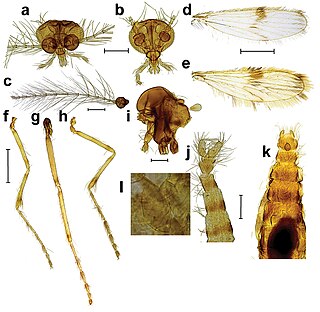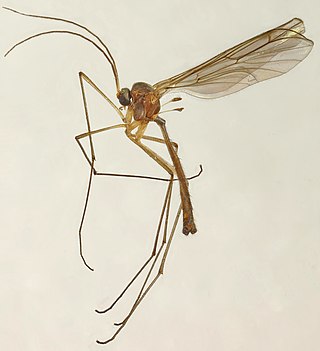
The Nematocera are a suborder of elongated flies with thin, segmented antennae and mostly aquatic larvae. This group is paraphyletic and contains all flies but species from suborder Brachycera, which includes more commonly known species such as the housefly or the common fruit fly. The equivalent clade to Nematocera is the whole Diptera, with Brachycera as a subclade. Families in Nematocera include mosquitoes, crane flies, gnats, black flies, and multiple families commonly known as midges. The Nematocera typically have fairly long, fine, finely-jointed antennae. In many species, such as most mosquitoes, the female antennae are more or less threadlike, but the males have spectacularly plumose antennae.

Mycetophilidae is a family of small flies, forming the bulk of those species known as fungus gnats. About 3000 described species are placed in 150 genera, but the true number of species is undoubtedly much higher. They are generally found in the damp habitats favoured by their host fungi and sometimes form dense swarms.

Corethrella is a genus of midges that are classified in the family Corethrellidae.

Tomoplagia is a genus of tephritid or fruit flies in the family Tephritidae.

Bolitophila is the sole living genus in the Bolitophilidae, a family of Diptera in the superfamily Sciaroidea, with around 40 Palaearctic and about 20 Nearctic species, and three species from the Oriental region (Taiwan). They are small (6–9 mm).

The Ditomyiidae are a small family of flies (Diptera).They are found worldwide, most species are found in the Australasian and Neotropical realms. There are only two genera in Europe Ditomyia Winnertz, 1846 and Symmerus Walker, 1848 Ditomyia is found in Central Europe Symmerus in Northern Europe Symmerus is endemic to the Palaearctic.
Allocotocera is a genus of flies in the family of Mycetophilidae. Two of the species are found in Europe.

Cyphomyia is a genus of flies in the subfamily Clitellariinae.
Euparyphus is a genus of flies in the family Stratiomyidae.
Psathyromyia carpenteri was first described as Phlebotomus carpenteri in 1953. The species name is dedicated to Col. Stanley Jennings Carpenter, M.S.C., U.S. Army, under whose direction most of the first described specimens were collected.

Lygistorrhininae, commonly called long-beaked fungus gnats is a subfamily of flies in the Diptera family Keroplatidae.
Rhipidita is a genus of fungus gnats in the family Ditomyiidae.
Nervijuncta is a genus of fungus gnats in the family Ditomyiidae.
Australosymmerus is a genus of fungus gnats in the family Ditomyiidae.
Xanionotum is a genus of flies in the family Phoridae.

Sciophila fractinervis is a species of fungus gnat in the family Mycetophilidae.
Paulo Iide was a Brazilian entomologist who worked at the Universidade Federal Fluminense and at the Instituto Oswaldo Cruz in Rio de Janeiro, specializing in soldier flies (Stratiomyidae) and horse-flies (Tabanidae).








